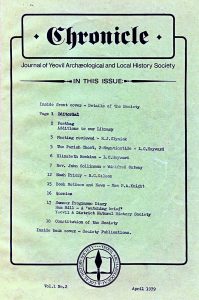1979-Apr-pg02_Postbag also The Society’s Library
This article came from the Chronicle published April 1979. Page 2
Postbag and Additions to the Library
Author: L.E.J.Brooke and Pat Knight
POSTBAG
To the Editor,
I have recently had some walling done in my garden using old stones from demolished buildings on Preston Road. As the texture and colour seemed rather different from the usual ‘Ham’ stone, I asked the builder if he knew where it had been quarried. He told me he understood it was ‘Yeovil’ stone from a quarry on the site of what is now Taylor’s Market and Court Ash. He said that St John’s Church had been built from this stone. As I have never heard of this quarry, neither have other Yeovilians to whom I have mentioned it, I wonder if any readers of ‘Chronicle’ have information about its existence and its working?
I note in Mr Atkins’ article on Thomas Hardy in Yeovil that mention is made of a musical trio playing in Maynard’s Restaurant during the afternoons. I can remember being sometimes taken there in the afternoons by my mother as a special treat and hearing them play but cannot now remember who they were. Perhaps the pianists were either Mr Ring or Mons Paquay when there were no matinees at the Central or Palace Cinemas? I wonder if any other old Yeovilians can remember?
Congratulations to all concerned with the first issue of ‘Chronicle’, I hope it will be the first of man” issues. How interesting to find one could ‘rent-an-anvil’ in the sixteenth century, when ‘rent-a-tool’ has only recently come again to Yeovil!
Arthur Denner.
(There is, indeed, a tradition that St John’s church was built from stone quarried from Court Ash which, it is claimed, accounts for the considerable depth of this site as compared with the height of the ground on which both St John’s church and the present Cattle Market are built. It is true the church is built of a local (‘Yeovil’) stone, but the tradition that it was taken from the Court Ash site does not gain support from the experts. There were several quarries on the outskirts of Yeovil at one time, and readers will be familiar with the name ‘Green Quarry’ on the Mudford Road, while there were others on the Ilchester and Larkhill Roads. Many walls still remain in the town built with this locally-produced stone. – Editor.)
THE SOCIETY’S LIBRARY
The following volumes have been added to the Society’s Library and are available for loan to members:
Bristol and Gloucestershire Archaeological Society Transactions,
Vols.LXXV – LXXXII, 1956-1963.
Calendar of Customs. Superstitions connected with the County of Somerset.
W.J.Cripps: Old English Plate, Ecclesiastical. Decorative and Domestic Its Makers and Marks: 1878.
C.Woodforde: Stained Glass, in Somerset, 1250-1830: 1946.
Miss Isobel Rendell, our Chairman, Mr W.T.J.Chapman, our Secretary, and Mr Leslie Brooke, Editor, are to be thanked for donating the above volumes.
Please apply to the Society’s Honorary Librarian, Mrs Pat Knight, either at meetings or at 24 Nash Lane, Yeovil (Telephone Yeovil 25434), in order to borrow Library items.
